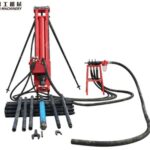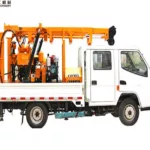Rotary drilling rig machine is a type of industrial drill that uses a rotating drill bit to break up subsurface formations. Different from percussion drilling, it utilizes a combination of rotational force, torque, and downward pressure weight-on-bit to crush and cut through rock and soil. The excavated material cuttings are continuously removed by circulating a drilling fluid mud or air, which also cools the bit and stabilizes the borehole. Rotary drilling rig is one of the most versatile and powerful pieces of equipment used in modern construction and mining industries. It is designed to create deep boreholes in soil, rock, and other ground formations. For foundation piling, water well drilling, oil exploration, or mining projects, rotary rigs deliver high precision, efficiency, and stability.


Features of Rotary Drilling Rig Machine
- High Drilling Efficiency
Rotary drilling machines are engineered to maximize drilling speed and productivity. Equipped with high-torque rotary heads and powerful hydraulic systems, these machines can quickly penetrate even the toughest ground conditions. The rotary motion, combined with the downward force applied by the drill string, ensures efficient removal of cuttings and rapid progress through the formation. - Precision and Accuracy
Accuracy is paramount in drilling operations, and rotary drilling rigs excel in this regard. Equipped with advanced guidance systems and precise control mechanisms, these machines can maintain a straight and vertical borehole path, even in challenging ground conditions. This precision is essential for ensuring the structural integrity of foundations, the efficiency of wellbores, and the accuracy of mineral exploration data. - Robust Construction and Durability
Built to withstand the rigors of heavy-duty drilling operations, rotary drilling rig machines are constructed from high-quality materials and components. The drill mast, rotary head, and other critical parts are designed to endure high loads and vibrations, ensuring long-term reliability and minimal downtime. Additionally, many machines feature modular designs that facilitate easy maintenance and repair, further enhancing their durability and cost-effectiveness.


Components of a Rotary Drilling Rig
- Mast or Derrick: The tall structural frame that provides height and support.
- Power Pack: The engine, diesel or electric, that generates hydraulic or mechanical power.
- Rotary Head: Applies rotation and downward force to the drill string.
- Drill String: The series of connected drill pipes that transmit power to the bit.
- Drill Bit: The cutting tool at the end of the string, available in various types.
- Hoisting System: The winch and pulley system for raising and lowering the drill string.
Advantages of Choosing a Rotary Drilling Machine
- High Precision: Accurate borehole drilling even in difficult terrains.
- Cost-Effective: The rotary drilling rig machine reduces project time and labor costs.
- Safety: Designed with advanced safety systems for operator protection.
- Long Service Life: Built to withstand harsh working environments.
Applications of Rotary Drilling Equipment
- Foundation Construction
In the construction industry, rotary drilling machines play a crucial role in creating deep foundation piles for buildings, bridges, and other structures. By drilling deep into the ground and filling the borehole with concrete or other materials, these machines create stable and load-bearing foundations that can withstand the forces of nature and the weight of the structure above. - Well Drilling
For water supply, oil and gas exploration, and geothermal energy projects, rotary drilling rig machines are used to drill wells of varying depths and diameters. These machines can be equipped with specialized bits and drilling fluids to optimize the drilling process and ensure the integrity of the wellbore. - Mineral Exploration
In the mining industry, rotary drilling rigs are essential for exploring and evaluating mineral deposits. By drilling core samples from deep within the Earth, geologists can analyze the composition and structure of rock formations, helping to identify potential mining sites and estimate the quantity and quality of mineral resources. - Geotechnical Engineering
Geotechnical engineers rely on rotary drilling rig machines to investigate the properties of soil and rock formations beneath the ground surface. This information is crucial for designing foundations, retaining walls, and other structures that interact with the subsurface environment. Additionally, drilling operations can be used to install instrumentation for monitoring ground movement, water levels, and other geotechnical parameters.



